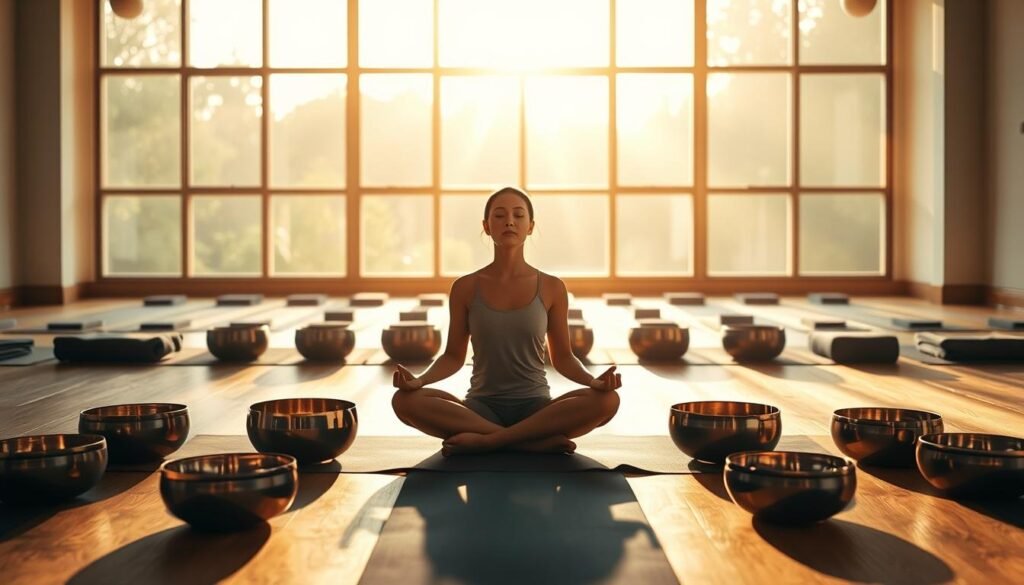
Imagine deepening your yoga practice with the soothing sounds of singing bowls. This creates a harmonious balance between body, mind, and spirit. The fusion of yoga and sound therapy has become popular for its potential to improve well-being.
This ancient practice combines yoga’s physical postures and breathing with singing bowls’ healing vibrations. It can lead to a more profound relaxation and meditation experience. By blending these two, people can reach a deeper state of calm and inner peace.
Key Takeaways
- Understand the benefits of combining yoga and singing bowl sound therapy.
- Learn techniques for integrating sound therapy into your yoga practice.
- Discover how this fusion can enhance relaxation and meditation.
- Explore the potential for improved mental and physical well-being.
- Get started with simple steps to incorporate yoga sound bath into your routine.
Understanding the Basics of Yoga and Singing Bowl Therapy
To start a journey that mixes yoga and singing bowl sound therapy, knowing the basics is key. This knowledge helps you get the most from combining these two practices.
The Essence of Yoga
Yoga is an old practice that includes physical poses, breathing methods, and meditation. It aims to balance the body, mind, and spirit. Regular yoga can make you more flexible, strong, and less stressed.
What Are Singing Bowls?
Singing bowls, also known as Himalayan bowls, are for sound healing and meditation. They make a deep sound that’s believed to heal. The vibrations from singing bowls are thought to calibrate the body’s energy, helping you relax and feel less anxious.
Benefits of Combining the Two Practices
Yoga and singing bowl therapy together can make both practices better. This mix can lead to a deeper state of relaxation, better stress relief, and overall health improvement. The vibrations from singing bowls can deepen the calm and well-being you feel during yoga.
This mix can also help you focus and concentrate better. The sound from singing bowls quiets the mind, helping you stay present during yoga. It also supports emotional balance and resilience, leading to a healthier lifestyle.
The Benefits of Yoga for Mental and Physical Health
Adding yoga to your daily routine can greatly improve your mental and physical health. It offers many benefits that boost your overall well-being.
Enhancing Flexibility and Strength
Yoga is great for making your body more flexible and strong. It uses poses and stretches to lengthen muscles and tendons. This makes your body more supple and resilient.
Key benefits include:
- Increased flexibility
- Improved muscle strength
- Better balance and coordination
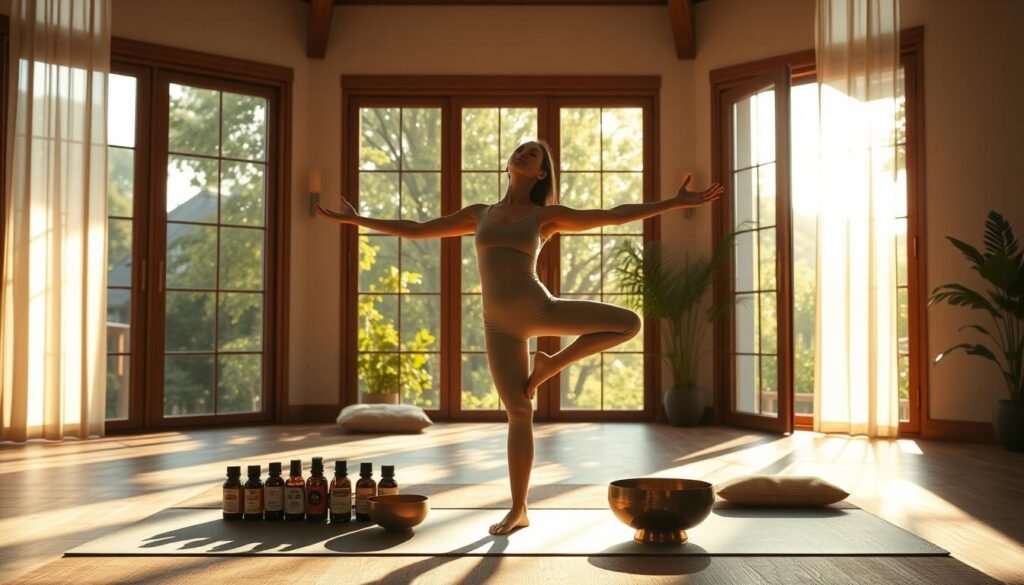
Stress Reduction and Emotional Balance
Yoga is also known for reducing stress and promoting emotional balance. It combines physical postures with deep breathing. This calms the mind and soothes the body.
The benefits of yoga for stress reduction include:
| Benefit | Description |
|---|---|
| Reduced anxiety | Yoga helps to calm the mind, reducing feelings of anxiety and worry. |
| Improved mood | The practice of yoga releases endorphins, which can improve mood and reduce symptoms of depression. |
| Enhanced emotional regulation | Yoga promotes emotional balance, helping individuals to better manage stress and negative emotions. |
By adding yoga to your routine, you can see these benefits for yourself. It leads to a more balanced and healthy lifestyle. Yoga with singing bowl therapy can even deepen these benefits, bringing a deeper relaxation and well-being.
Sound Therapy: The Science Behind Singing Bowls
The science of singing bowls is fascinating. It shows how sound therapy and yoga work together. This combination offers deep benefits for those who practice.

How Sound Affects the Brain
Studies have found that singing bowls’ sound changes brainwaves. This leads to relaxation and less stress. It does this by matching the brain’s frequency with the sound of the bowls.
The brain’s response is strong. It can lower anxiety and boost mood. Adding yoga to this sound therapy makes for a complete wellness approach.
The Role of Frequency in Healing
Different sounds affect the body and mind in various ways. Singing bowls create a range of sounds, each with healing properties. For example, some sounds help with emotional balance, while others improve physical health.
Using singing bowls in yoga lets people tap into sound’s healing power. By knowing how frequency heals, they can focus on specific benefits. This could be reducing stress or increasing flexibility.
Creating a Harmonious Space for Practice
A harmonious space can make your yoga and singing bowl practice better. It helps you relax deeper and find inner peace. Think about the environment and the tools you use.
Choosing the Right Environment
Find a quiet, clean spot to practice. This helps you focus and enjoy the benefits. Make sure it’s well-ventilated and comfy.
- Look for a quiet spot away from noise.
- Keep the area clean and free from distractions.
- Use calming colors or decor to set the mood.
Essential Tools and Equipment
Good tools make your practice better. You’ll need a quality yoga mat and singing bowls.
Key Equipment:
- A good, non-slip yoga mat.
- Singing bowls in different sizes and sounds.
- A striker or mallet for playing the bowls.

Choose the right place and tools for a great yoga and singing bowl experience. It will be truly immersive and beneficial.
Basic Yoga Poses That Pair Well with Sound Therapy
Some yoga poses are great for sound therapy, making the experience better. By combining yoga poses with singing bowls, you can deepen your practice. This can also increase its benefits.
These poses are basic and easy to add sound therapy to. They’re perfect for those who want to try yoga and sound healing together.
Child’s Pose
Child’s Pose, or Balasana, is a resting pose that feels rejuvenating with singing bowl sounds. Place a singing bowl near your head or heart. This lets the vibrations resonate through your body.
Benefits: This mix can calm your mind, lower stress, and bring inner peace.
Warrior II
Warrior II, or Virabhadrasana II, is a strong standing pose that shows strength and focus. Adding singing bowl sounds to this pose can boost your concentration and balance.
To use sound therapy, strike the singing bowl as you inhale. Let the sound resonate as you hold the pose. Then, exhale, creating a flow between breath, movement, and sound.
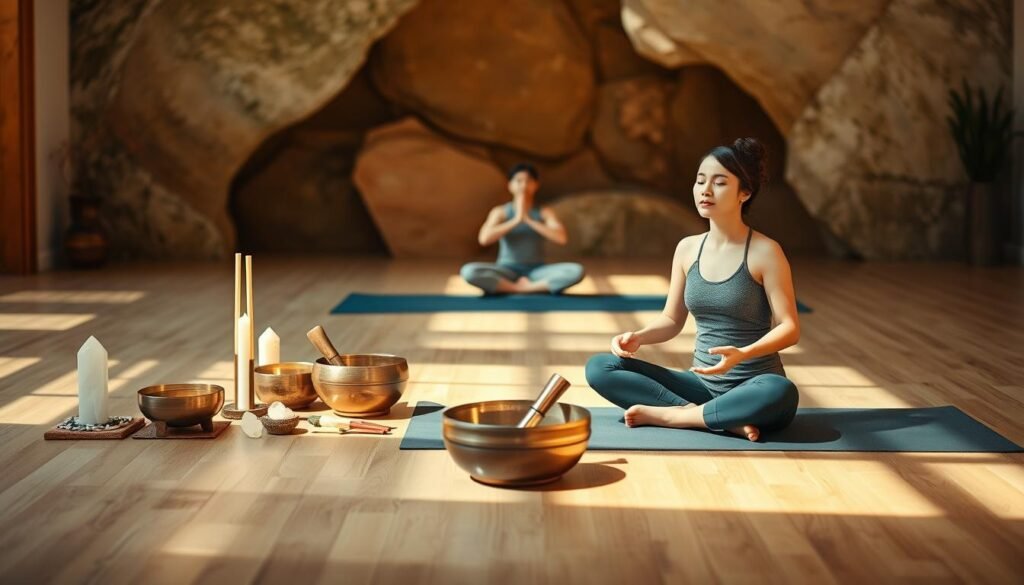
Savasana
Savasana, or Corpse Pose, is a deep relaxation pose. It’s perfect for sound therapy. Place a singing bowl near your body or have someone play it nearby to enhance relaxation.
Tips: Try different bowl sizes and placements to find what works best for you. This can improve your relaxation experience.
Techniques for Integrating Singing Bowls into Yoga Practices
To blend singing bowls into yoga, you need to know about timing, placement, and breathing. These elements help make your practice more harmonious and healing. It boosts your physical, emotional, and mental health.
Timing and Placement of Sound
The timing and where you place the sound in your yoga matters a lot. Here are some tips to make the most of it:
- Start with a few minutes of singing bowl sound to calm the atmosphere.
- Use the bowl to signal when to move to a new pose or when to end your practice.
- Put the bowl near your mat so the sound wraps around you.
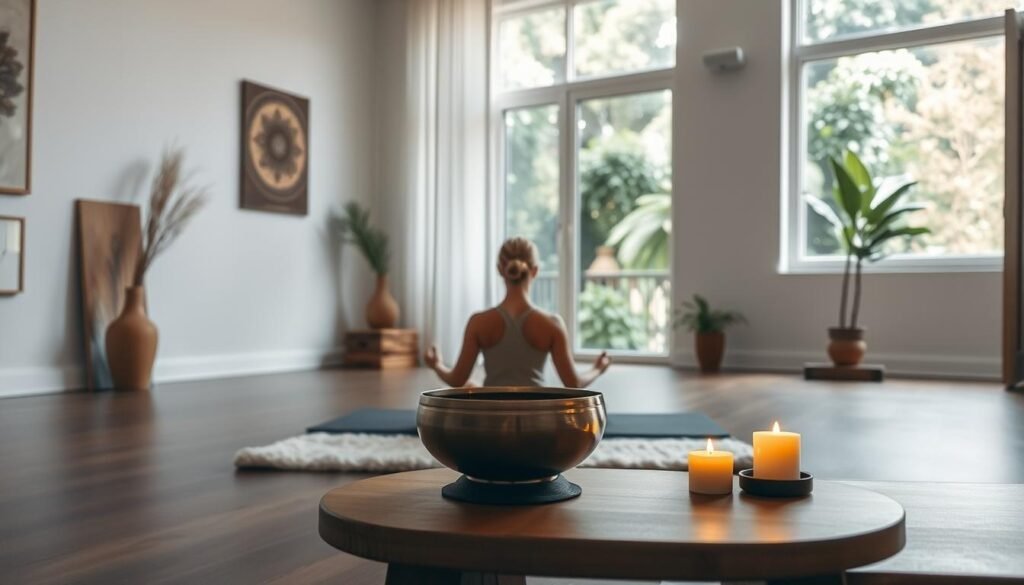
Breathing Practices to Enhance Experience
Breathing is key in yoga, and singing bowls make it even better. Here’s how to improve your practice:
- Match your breath with the bowl’s sound, breathing in and out with the vibrations.
- Deep, belly breathing makes the sound therapy’s relaxing effects stronger.
- Keep your focus on breathing and let the bowl’s sound lead you to a deeper state of calm and mindfulness.
By using these methods in your yoga, you can have a powerful and healing experience. It will care for your body, mind, and spirit.
Guided Sessions: Connecting Yoga and Sound Therapy
Guided sessions are perfect for beginners in yoga and sound therapy. They offer a supportive space to learn. Here, you can see how yoga and singing bowls work together.
Finding Quality Recordings or Classes
Finding good recordings or classes is key. Here are some tips:
- Research Online Platforms: Look for trusted websites and apps with yoga and sound therapy sessions. They cater to all levels and needs.
- Check Instructor Credentials: Make sure the teachers know yoga and sound therapy. This ensures a safe and effective practice.
- Read Reviews and Testimonials: What others say can help you choose the best sessions.
Essentials for an Online Experience
For the best online sessions, set up your space right. Here’s what you need:
| Essential | Description |
|---|---|
| Quiet Space | Choose a quiet, comfy spot for your practice, away from distractions. |
| Good Sound Quality | Use a good sound system or headphones for the best singing bowl experience. |
| Minimal Lighting | Keep the lights low to help you relax. |
With these tips, you can make a peaceful space for your yoga and sound therapy sessions.
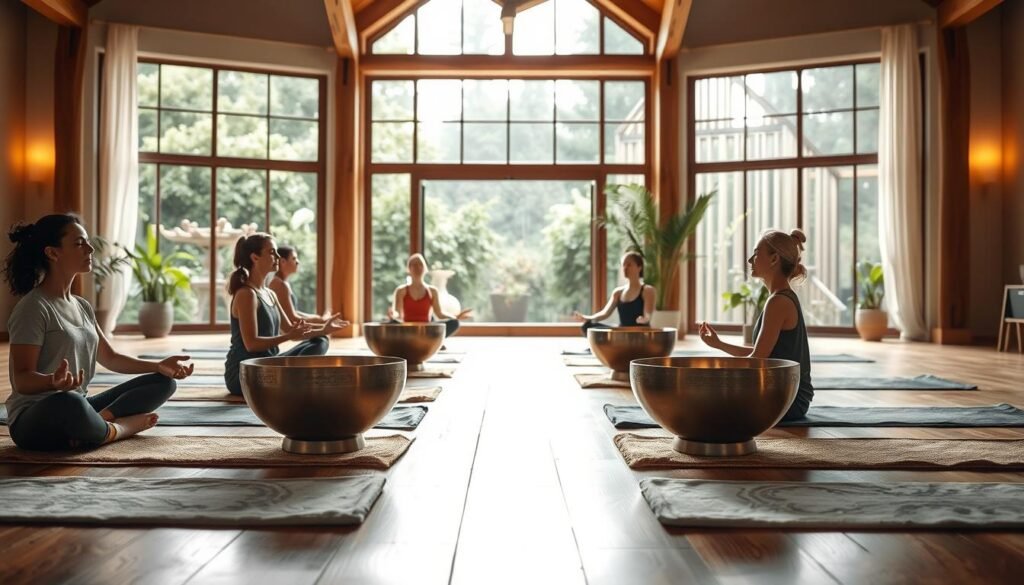
Guided sessions are great for deepening your practice. They help you see how yoga and sound therapy work together. By choosing quality sessions and setting up your space well, you can improve your mindfulness and relaxation journey.
Practicing Mindfulness Through Combined Sessions
Yoga and singing bowl sound therapy together create a deeper state of mindfulness. This combination helps people stay present and aware more deeply.
Techniques to Stay Present
To get the most out of yoga and singing bowl sessions, use certain techniques. Focus on your breath to stay in the moment. Deep, controlled breathing calms the mind and boosts sound therapy’s effects.
Also, listen closely to the singing bowls’ sound. Letting the sound waves reach deep inside helps you meditate better. This improves your mindfulness.
Journaling After Sessions
Writing in a journal after a session is very helpful. It lets you share your thoughts, feelings, and insights. This helps you see how you’ve grown and what you’ve learned.
Writing regularly helps you spot patterns and areas to improve. It makes your practice stronger and boosts your mindfulness.
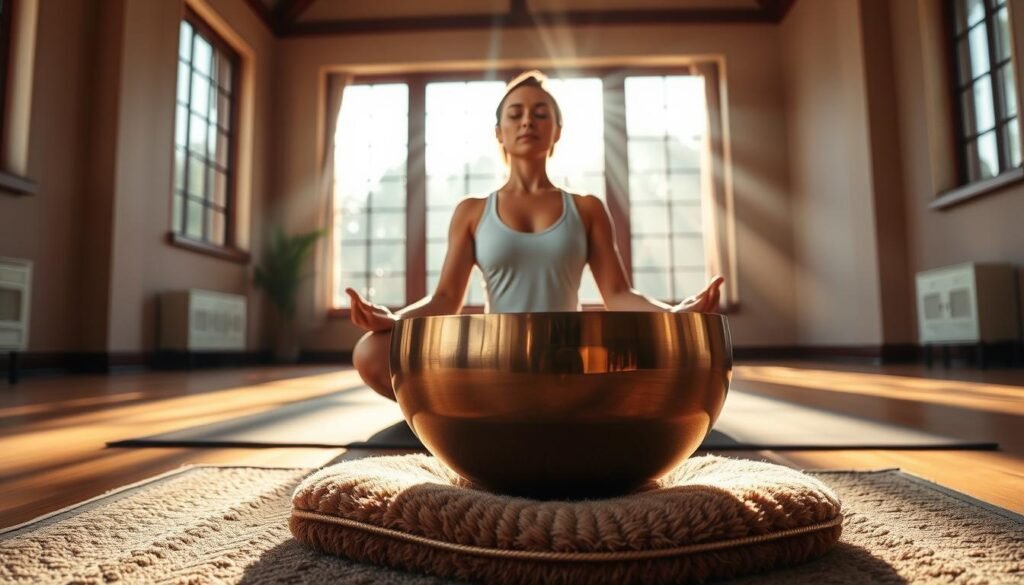
Tips for Beginners: Starting with Yoga and Singing Bowl Therapy
Starting yoga and singing bowl therapy needs patience, dedication, and a willingness to explore new wellness dimensions. As a beginner, it’s key to see this journey as more than just physical postures or sound healing. It’s about deepening your connection with yourself.
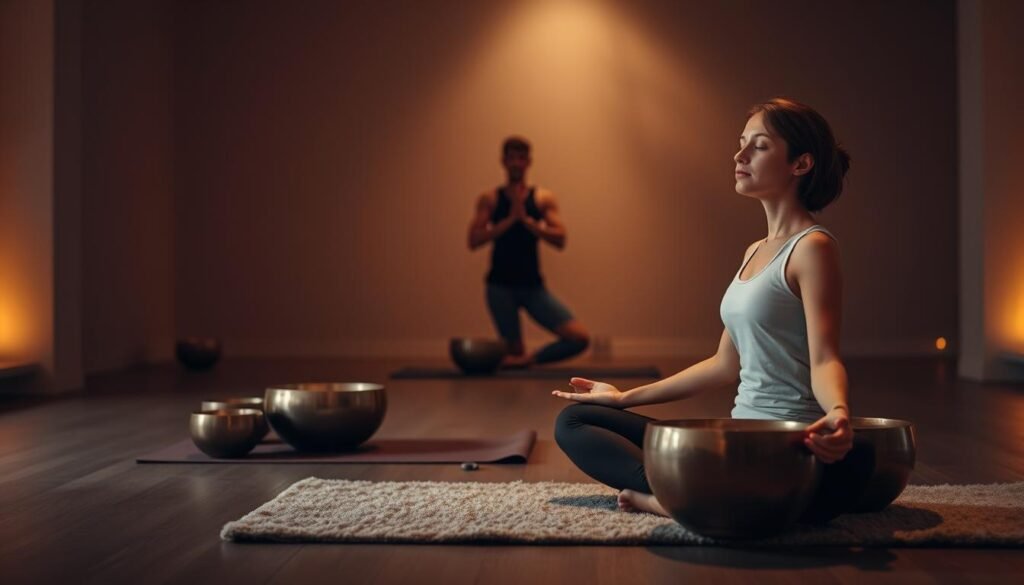
Setting Realistic Goals
One crucial step is setting realistic goals. Start with short sessions, like 10-15 minutes a day. Then, increase the time as you get more comfortable. Setting specific goals, like improving flexibility or reducing stress, can also guide your practice.
- Begin with manageable daily commitments.
- Focus on your breath and the sensations in your body.
- Be gentle with yourself; it’s a journey, not a competition.
Building a Consistent Practice
Consistency is key for yoga and singing bowl therapy benefits. Practice at the same time every day to create a routine. Keeping a journal to track your progress and reflect on your experiences can be helpful.
To maintain a consistent practice, consider these tips:
- Create a dedicated space for your practice that is quiet and free from distractions.
- Start with simple yoga poses and gradually move to more complex ones.
- Experiment with different singing bowl sounds to find what resonates with you.
By combining yoga with singing bowl sound therapy, you’re not just exercising or relaxing. You’re on a holistic journey that nourishes both body and soul. Remember to be patient and compassionate with yourself. Don’t hesitate to seek guidance from experienced practitioners.
Maintaining Your Practice: Continuing to Grow
As you keep practicing yoga and singing bowl sound therapy, try new techniques to deepen your practice. Adding complex yoga poses and sound healing methods can make your experience richer. You’ll feel more relaxed and at peace.
Advanced Relaxation Methods
Take your yoga and sound healing to the next level by trying different singing bowl techniques. Use various bowl sizes, experiment with playing styles, and add guided meditations. This will enhance your relaxation and inner peace.
Community and Resources
Connecting with others who love yoga and singing bowl therapy is very helpful. Look for local yoga studios, online forums, or social media groups. These resources offer knowledge, support, and guidance. They help you grow and find new ways to blend yoga and sound healing into your life.
